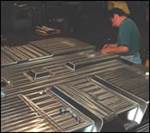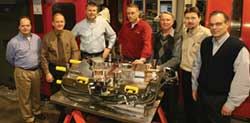Commercial Tool & Die: High Quality and Employee Innovation Drive Success
Unique, employee-developed programs tighten this moldmaker’s leadtimes—resulting in high quality tools delivered on time and the MoldMaking Technology 2008 Leadtime Leader Award: Large Shop.
Specializing in the design, manufacture, repair and maintenance of plastic injection molds, Commercial Tool has managed to stay successful through industry ups and downs by stepping up the quality of its molds. Photos courtesy of Commercial Tool & Die, Inc.
For 54 years, Commercial Tool & Die, Inc. (Comstock Park, MI) has been combining standardization, training and employee innovation with the latest in equipment and technology to produce the highest quality molds primarily for the automotive, appliance and furniture industries. Proof of this can be found in annual sales in 2006 of $22.7 million and an impressive sales growth of 10.8 percent—not bad for a 126-person shop.
Specializing in the design, manufacture, repair and maintenance of plastic injection molds, Commercial Tool has managed to stay successful through industry ups and downs by stepping up the quality of its molds, according to VP of Operations, Todd Finley. “Several of our competitors have set up off-shore alliances to blend programs,” Finley notes. “Our response has been to shower our customers with quality. We made a large investment in high-speed machining centers. This investment helps us reduce EDM, spotting, and benching operations to improve quality and reduce leadtimes. We also are developing our own off-shore alliances.”
A Little History
Commercial Tool & Die, Inc. was founded by Al Bouwman in 1953. His son Doug took an active position with the company in 1979. Commercial Tool—together with CG Plastics and CG Automation—provides fixtures, special machinery, custom molding and sampling, as well as plastic injection molds.
Leadtime Challenges and Rewards
The company’s average leadtime on a project is 11 weeks and is measured from sales order to first shot. Milestone dates are entered into the company’s ERP system at the time they occur. This ERP system has a Leadtime Report developed by the company’s IT department. “Average leadtime is now a metric on its organizational scorecard,” explains Don Brecken, Commercial Tool’s Director of Quality. “This calculation includes all jobs—regardless of size and complexity.”
To maintain these leadtimes, the company uses a “front end loading the project” approach. It is written in Commercial Tool’s process that design has 72 hours (or less) to complete a concept design and present it to management upon receipt of a launch packet. “This initial review provides enough detail for management to either approve the design or approve the design with changes. We then meet with our customer for steel approval,” explains Finley. “Getting designs off the ground quicker and ordering steel sooner allows Commercial Tool more time for manufacturing.
“We utilize solid model design, paperless manufacturing, high-speed machining, and shop floor programming to reduce tool build labor downstream,” Finley continues. “Each component is scheduled and arrives at the mold build area at the optimal time.”
Commercial Tool’s continuous improvement efforts reduce disruptions and eliminate redundant manufacturing processes. “Improvements become the new best practice through standardization and training to ensure these improvements are consistently applied and long-lasting,” Brecken emphasizes.
These leadtime efforts have paid off. “One positive is improved on-time delivery,” Finley notes. “Our average on-time delivery two years ago was 60 percent at best. Today, we average better than 94 percent on-time delivery and 13 of the past 18 months we delivered 100 percent on-time
Automation Drives Processes
Commercial Tool’s successful leadtime reduction would not have happened without the company’s investment in automation. The company has a variety of automated work processes, including automatic toolchangers on all CNC equipment; unattended machining and programming ahead while machining (machinists program their own work); automatic BOM generation from design through the ERP system that feeds the purchasing process; automated vending of perishable tooling to machinist and moldmakers (Auto-Crib); and purchase suggestions that are generated automatically from the ERP system for other perishable tooling and purchased components. This automation drives other processes such as production planning and scheduling.
The company also is in the final stages of upgrading its feature-based recognition machining. It is currently in use in the Design and CAD departments. “On the production floor, they are rewriting programs daily that incorporate the new feature-based recognition,” Brecken explains. “That will take us to the next level—reducing our internal disruptions that can add to leadtime. We should be in full swing by early 2008.”
These processes—combined with lean initiatives like standardized component manufacturing, process mapping, auto-vended tooling and employee involvement on corrective action team—further strengthen the company’s reputation as a leader in leadtimes.
According to Commercial’s Design Manager, Mike Monje, the company uses CAD as its master manufacturing system. “Our 3-D solid tool design is the master file from which all CNC cutting files are created,” Monje explains. “In order to track, control and manage this data in real-time, we developed a unique naming convention and data structure which allows us to control and manage the data through our Intranet database system. We developed this Intranet system internally so it is tailored to our exact needs. The system is deployed throughout the shop—allowing all employees access to the same information in real-time.”
A Strong Workforce
Owner and President Doug Bouwman cannot emphasize enough that Commercial Tool’s employees are the backbone to its accomplishments. An example of how employee loyalty, work ethic and ideas contribute to success lies with the Disruption Tracking/Flow Interrupter Process developed in-house. “This one-of-a-kind process allows our employees to electronically record those things that get in the way of them doing their jobs,” Brecken explains. “Disruptions logged are evaluated by Commercial Tool’s Corrective Action Steering Committee. The Steering Committee is comprised of members of Commercial Tool’s leadership team who own various processes and have responsibility for corrective action. This committee looks for trends and patterns in the data using Pareto analysis to determine those disruptions having the biggest impact on operations. Commercial Tool’s formal corrective action process—which is much the same as an 8D—is then used to drive root cause corrective action. This process has been embraced and is now embedded in our culture.”
Another example of the employees’ exceptionality is its Machine Department Scorecard. “Moldmakers are now scoring the quality of work coming from all of the many areas of our machine department,” Plant Manager Dave Ketelaar notes. “This scorecard was developed by a cross-functional team of moldmakers, machinists and management. Data from completed scorecards are aggregated to create an overall report that the machine department supervisor uses to drive improvement.”
Team Talent
Commercial Tool uses a team approach to drive success. “If the company is not successful, the individuals are not successful—win as a team, lose as a team,” states Bouwman.
Alliances with local college and university co-ops, internships and apprenticeship programs allow Commercial Tool to hire the top candidates in the industry, according to Ray Henkel, VP of Engineering. “We made a strategic decision to recruit talented students from such programs,” Henkel adds. “This strategy allows both Commercial Tool and the potential employee a try-out period before making any commitment. This also allows the student a chance to train on some of the industry’s best equipment.”
The company also has an in-house training program called Commercial Tool University. This in-house training program was recently recognized by the Department of Labor as an in-house apprenticeship program for moldmaking and machinists. “This strategy represents an unprecedented commitment to employee skill development,” Finley says.
An Achievable, Sustainable Vision
Bouwman is satisfied that Commercial Tool is on the right path for continued growth and profitability. “We have evolved into the organization we need to be for the foreseeable future,” he states. “Our existing plan is for sustainability.” To that end, Commercial Tool recently instituted the following plan to sustain the organization through the deployment of its new vision and core values: “Sustainable Vision—To be an organization that sustains itself as a preferred supplier of high-quality tooling at a fair price, an industry leader in efficiency and quality, a leader in the community, and an employer of talented and dedicated professionals; and, Core Values—Commercial Tool was founded with a strong commitment to integrity and doing the right thing for customers, employees, business partners and neighbors. Living our core values in all we do is essential to our success. At Commercial Tool, we tell the truth, keep commitments. treat people with dignity and respect, act with integrity and have a strong work ethic.”
Commercial Tool will use this philosophy to continue to focus on identifying best practices, developing production standards and skills training. Finley concludes, “What makes us unique is our consistent dedication to new technology, new ideas and our quality management system. New technology, training and exposure to what will be available tomorrow foster new ideas for today—and future planning for implementation in the coming months and years.”
Related Content
How to Solve Hot Runner Challenges When Molding with Bioresins
A review of the considerations and adaptations required to design hot runners and implement highly productive injection molding operations.
Read MoreHands-on Workshop Teaches Mold Maintenance Process
Intensive workshop teaches the process of mold maintenance to help put an end to the firefighting culture of many toolrooms.
Read MoreLeading Mold Manufacturers Share Best Practices for Improving Efficiency
Precise Tooling Solutions, X-Cell Tool and Mold, M&M Tool and Mold, Ameritech Die & Mold, and Cavalier Tool & Manufacturing, sit down for a fast-paced Q&A focused on strategies for improving efficiencies across their operations.
Read MoreMMT Chats: Eliminating the Noise to Stay Focused on the Customer
Metro Mold & Design joins me to discuss the value of the 80/20 rule as a business strategy, its talented cross-functional team, the role of automation in mold building and molding, and the continuing impact of COVID-19.
Read MoreRead Next
Chicago Mold Engineering: In The Spotlight
Focusing on a niche in the automotive headlap reflector market—coupled with the most advanced technologies and mold manufacturing techniques—lights the way for this moldmaker’s 2007 Leadtime Leader Award: Large Shop.
Read MoreReasons to Use Fiber Lasers for Mold Cleaning
Fiber lasers offer a simplicity, speed, control and portability, minimizing mold cleaning risks.
Read MoreHow to Use Strategic Planning Tools, Data to Manage the Human Side of Business
Q&A with Marion Wells, MMT EAB member and founder of Human Asset Management.
Read More
























